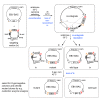Epstein-Barr virus genetics: talking about the BAC generation
- PMID: 21429237
- PMCID: PMC3063228
- DOI: 10.1186/2042-4280-1-6
Epstein-Barr virus genetics: talking about the BAC generation
Abstract
Genetic mutant organisms pervade all areas of Biology. Early on, herpesviruses (HV) were found to be amenable to genetic analysis using homologous recombination techniques in eukaryotic cells. More recently, HV genomes cloned onto a bacterial artificial chromosome (BAC) have become available. HV BACs can be easily modified in E.coli and reintroduced in eukaryotic cells to produce infectious viruses. Mutants derived from HV BACs have been used both to understand the functions of all types of genetic elements present on the virus genome, but also to generate mutants with potentially medically relevant properties such as preventative vaccines. Here we retrace the development of the BAC technology applied to the Epstein-Barr virus (EBV) and review the strategies available for the construction of mutants. We expand on the appropriate controls required for proper use of the EBV BACs, and on the technical hurdles researchers face in working with these recombinants. We then discuss how further technological developments might successfully overcome these difficulties. Finally, we catalog the EBV BAC mutants that are currently available and illustrate their contributions to the field using a few representative examples.
Figures




Similar articles
-
Rapid CRISPR/Cas9-Mediated Cloning of Full-Length Epstein-Barr Virus Genomes from Latently Infected Cells.Viruses. 2018 Apr 3;10(4):171. doi: 10.3390/v10040171. Viruses. 2018. PMID: 29614006 Free PMC article. Review.
-
Contribution of viral recombinants to the study of the immune response against the Epstein-Barr virus.Semin Cancer Biol. 2008 Dec;18(6):409-15. doi: 10.1016/j.semcancer.2008.09.001. Epub 2008 Sep 30. Semin Cancer Biol. 2008. PMID: 18938248 Review.
-
[Gene modification in the genome of Epstein-Barr virus cloned as a bacterial artificial chromosome].Wei Sheng Wu Xue Bao. 2008 Mar;48(3):385-90. Wei Sheng Wu Xue Bao. 2008. PMID: 18479068 Chinese.
-
Construction of an infectious clone of canine herpesvirus genome as a bacterial artificial chromosome.Microbes Infect. 2006 Apr;8(4):1054-63. doi: 10.1016/j.micinf.2005.11.004. Epub 2006 Jan 19. Microbes Infect. 2006. PMID: 16515874
-
Cloning of herpesviral genomes as bacterial artificial chromosomes.Rev Med Virol. 2003 Mar-Apr;13(2):111-21. doi: 10.1002/rmv.380. Rev Med Virol. 2003. PMID: 12627394 Review.
Cited by
-
Epstein-Barr virus late gene transcription depends on the assembly of a virus-specific preinitiation complex.J Virol. 2014 Nov;88(21):12825-38. doi: 10.1128/JVI.02139-14. Epub 2014 Aug 27. J Virol. 2014. PMID: 25165108 Free PMC article.
-
Epstein- Barr Virus: Clinical and Epidemiological Revisits and Genetic Basis of Oncogenesis.Open Virol J. 2015 Nov 3;9:7-28. doi: 10.2174/1874357901509010007. eCollection 2015. Open Virol J. 2015. PMID: 26862355 Free PMC article.
-
Heterogeneity of the Epstein-Barr Virus (EBV) Major Internal Repeat Reveals Evolutionary Mechanisms of EBV and a Functional Defect in the Prototype EBV Strain B95-8.J Virol. 2017 Nov 14;91(23):e00920-17. doi: 10.1128/JVI.00920-17. Print 2017 Dec 1. J Virol. 2017. PMID: 28904201 Free PMC article.
-
The Epstein-Barr Virus BART miRNA Cluster of the M81 Strain Modulates Multiple Functions in Primary B Cells.PLoS Pathog. 2015 Dec 22;11(12):e1005344. doi: 10.1371/journal.ppat.1005344. eCollection 2015 Dec. PLoS Pathog. 2015. PMID: 26694854 Free PMC article.
-
Epstein-Barr virus-mediated transformation of B cells induces global chromatin changes independent to the acquisition of proliferation.Nucleic Acids Res. 2014 Jan;42(1):249-63. doi: 10.1093/nar/gkt886. Epub 2013 Oct 3. Nucleic Acids Res. 2014. PMID: 24097438 Free PMC article.
References
LinkOut - more resources
Full Text Sources
Other Literature Sources

